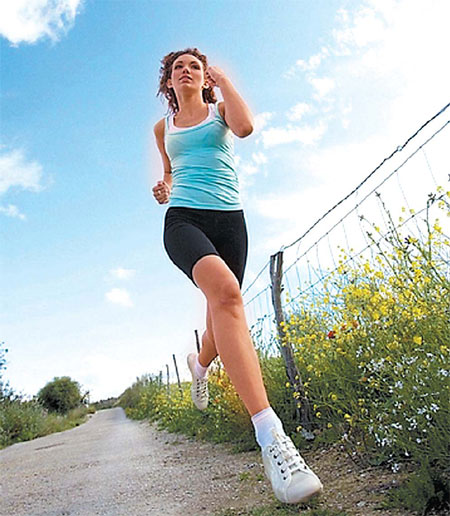Forget the finish line
 |
| The Alexander Technique can be effective in helping keen runners avoid injuries. Quanjing |
"Think of running over the ground, rather than into it," says the owner of the guiding hands. He is Malcolm Balk, an Alexander technique teacher and running coach who has created a new approach to running.
Twenty-five years ago, Balk was a promising marathon runner, but he was plagued by injury. He stumbled across the Alexander technique when learning to play the cello and eventually trained to teach it. He soon noticed that he was running not only injury-free but faster, too. This prompted him to develop "the art of running" which combined the two.
In the same way that the Alexander technique isn't a precisely defined group of exercises, Balk's take on running isn't rigid. He aims to increase our awareness of what we're doing when we're pounding the pavements so that running becomes an ongoing process of exploration rather than simply a means of getting fit or reaching the finish line.
"It's important to pay attention to your 'kinaesthetic conscience' - to what's going on within your body," he says. This attention is what allows us to become aware of faulty movement patterns, bad posture, muscular tension and tightness. In Alexandrian terms, identifying these habits of misuse is the first step to eliminating them.
Like most runners, I have completed the odd training session or race on painkillers and through gritted teeth only to pay the price later. In the Alexander technique, ignoring the journey to focus on the destination is called end-gaining, an approach Balk believes is behind the high level of injury and drop-out among runners.
"Statistics show that two-thirds of runners get an injury every year," he says. "When you are injured, you can't train and when you can't train, you can't improve."
Injured runners are often told they need to improve their core stability, correct muscle imbalances, alter their running style or wear orthotics in their shoes (or all of these) to avoid future problems. But Balk is more interested in getting people to "let go" than in using more muscle, more force, more control.
For example, he observes that I brace my core muscles and tuck my pelvis under before I even take a step. This, Balk explains, causes me to anchor my ribs against my spine, restricting my breathing. This, in turn, makes me lift my sternum to open my chest and get more oxygen in, which increases the arch, and stress, in my lower back.
To illustrate the point, Balk performs an experiment on me. First, he gets me to stand as I normally do, with my tummy sucked in, pelvis tilted under and bottom squeezed. He pushes down on my shoulders. "Where do you feel that?" He asks. My tailbone, I reply. "Now just let it all go, let your ribs relax, unclench your butt and untilt your pelvis," he says. He pushes down again. "Where do you feel it now?" My feet, I say.
That is one of the funny things about the Alexander technique. It's often less about doing than not doing, which can be a tricky concept for runners - who tend to be natural end-gainers - to grasp.
Frederick Matthias Alexander, who developed the technique, says: "Stop what you are doing wrong, and the right will take care of itself." That said, mastering the art of running does entail a few practical shifts in technique.
"We're aiming for less 'muscling' to create movement," Balk explains. "So if we let the feet land underneath the body, rather than way out in front - we reduce the 'braking effect' and negate the need to push so hard with the front of the thighs."
While the muscles along the front of the thighs are often overused in running - and therefore grow tight and short - the hamstrings, along the back of the thighs, often contribute less than their fair share.
Balk tethers my ankles to a bungee cord to create some resistance and help me get the sensation of engaging my hamstrings to pick up my feet. This drill also helps reduce ground contact time - creating a shorter, snappier stride and the feeling of "running over your feet".
It is with this in mind that we begin our trot around the square - and what enables me to feel that I am running lightly and with bounce, rather than excavating great holes in the grass.
Balk's approach to running has much value. The prospect of fewer injuries, greater comfort and improved performance would have any runner's heart beating a little faster. But its greatest strength for me is in viewing running as a work in progress. Every step is a potential learning experience - a chance to explore how it feels if you land a bit more like this or breathe differently, or use your arms a little more... With so much to think about, running can never be boring.
The Guardian
(China Daily 11/14/2007 page19)














